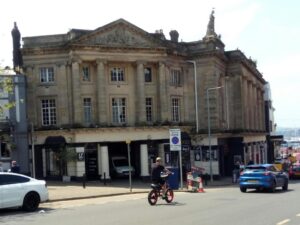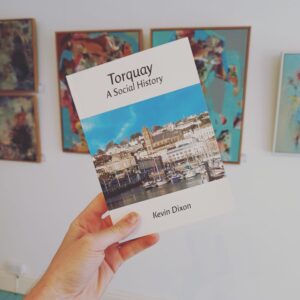Torquay wanted an opera house. Torquay deserved an opera house.
We were the richest town in England, the leisure epicentre of the largest empire the world had ever seen. As the twentieth century began more European royalty could be seen in the resort than anywhere else in the world. Alongside other elite visitors and locals, they expected a very special cultural offer, the best entertainment, an experience to rival the great cities.
Opera was the ultimate art form, suitable for portraying the greatest aspirations of heroic men and women. So, in the early years of the twentieth century, construction began on the Scala Theatre near the Strand.
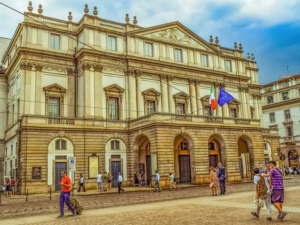 Milan’s eighteenth-century opera house
Milan’s eighteenth-century opera house
The model was La Scala, the magnificent eighteenth-century opera house in Milan where many of the finest singers from around the world performed. Italian imitations were always part of our English Riviera, and this was to be the next phase in the resort’s forever campaign for equivalence.
Torquay’s Scala began in 1909 as a magnificent classical Bath stone building in three storeys, with an Ionic order of columns rising above a lower order of Doric columns, the parapets forming pedestals for sculptures.
Torquay’s Scala. Never used as it was intended
The building was deeply symbolic and there was no denying the good reasoning behind why the resort fashioned itself around appealing to the refined tourist. 55% of English people were visiting the seaside on day excursions by 1911, while 20% were taking holidays requiring accommodation. This reliance on spectacle was therefore an understandable response to the reality of the paying visitor who generated revenue that, in ideal circumstances, would benefit all social classes.
But Torquay’s much anticipated opera house would never be completed. Everything would abruptly change.
Indeed, some historians see 1914 as the real end of a Long Nineteenth Century. This was the sudden conclusion of a British Belle Époque, our ’Beautiful Era’, characterised by optimism, economic prosperity, colonial expansion, and technological and cultural innovation.
In 1918 Spanish Flu killed 96 Torquay residents in a few weeks
All had appeared well at the turn of the century, but World War I was a prolonged, brutal, and costly conflict; and was immediately followed in 1918 by a virulent pandemic which killed 96 Torquay residents in a few weeks.
The impact of the so-called Spanish Flu was severe, with theatres, dance halls, churches and other public-gathering places being closed. The exceptional nature of the pandemic, its rapidity and randomness, was described in 1919 by our health authority:
“The disease was of an unusual type. The onset being quickly followed by a toxic form of pneumonia, which was little effected by treatment and rapidly proved fatal. Strong robust individuals and pregnant women nearing the end of their confinement were common victims. In the latter abortion took place, quickly followed by death”.
By 1921 Torquay’s male population had fallen to 15,936; while the female population stood at 23,495. All were affected by those two seismic events in a time of grief, social change and the end of certainties. The historian Correlli Barnett argues that the ensuing erosion of self-confidence “crippled the British psychologically“.
In what some called a Morbid Age, the physical manifestations of mourning could be viewed in the town’s workplaces and in private shrines in so many homes. 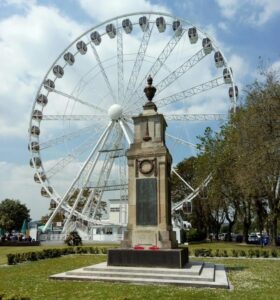
Blomfield’s 1920 War Memorial in Princess Gardens with 609 named there
Remembering was rightly manifest in the building of monuments to the Fallen, the most notable being Blomfield’s 1920 War Memorial in Princess Gardens. Few would not have known a friend or family member among the 609 named there, while all around those broken in body and mind could be seen in the resort’s streets.
As Torquay entered the ‘Roaring Twenties’, it steadily became evident that this would be a decade of contrasting and polarising experiences.
The ‘Bright Young Things’, those born after the turn of the century and with the privilege of wealth, had a good life in a party town. Yet, though they may have been liberated from the restrictions their Victorian parents experienced, perhaps they lived with a sense of guilt and compensated through a life of hedonism.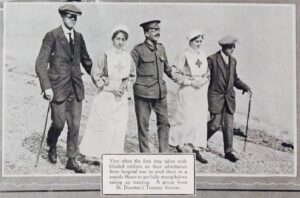
Blind veterans on the beach
Conversely, those returning to the Bay from Flanders, expecting the “land fit for heroes” promised by Lloyd George, were to be disappointed. Wages were being cut as the country had lost overseas markets and faced growing competition, particularly from the USA and Japan. Many would face a period of unemployment, deflation and economic decline.
Other overseas events would additionally effect Torquay. The English Riviera self-image presupposed an international town, the product of a benign imperial mission. Yet the Empire was fraying and the treasured family of nations beginning to dissolve. Debates over Irish Home Rule had divided Torquay’s politics for decades and now England’s oldest overseas colony had finally decided on divorce. Further afield, participation in the War fuelled a growing nationalism. Many recognised that it would be only a matter of time before the Empire was dismantled entirely.
At home, all faced a decade of disorientation. Having taken a century to build up, convictions and accepted truths crumbled as long-accepted hierarchies of class and gender were dismantled, creating a modern resort so very different to that of the Victorians.
Torquay’s target audience, the upper-class visitor, had been profoundly affected by the War. Across the nation, the elite had taken the greatest proportional hit, with upper class officers five times more likely to die as an ordinary Tommy. There were just fewer confident and educated sons of privilege around.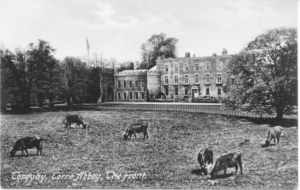
The Cary family, owners of Torre Abbey since 1662, sold up in 1930
Property-owning lifestyles were predicated on cheap labour with servants knowing their place. Conscription had eroded traditional class distinctions and self-regulating deference. Many in the working class had grown to like earning good wages in factories and there was little interest in returning to the long hours and drudgery of life in service.
Cockington’s Mallocks left in 1932
Over a few short years, Britain’s great houses became expensive relics of the past, and many were subsequently demolished or sold. The Palk/Haldon family had begun to withdraw from Torquay in 1885 and had gone by 1914. The Cary family, owners of Torre Abbey since 1662, finally sold in 1930. Cockington’s Mallocks had been here since 1654, but also disposed of the estate to Torquay Borough Council in 1932.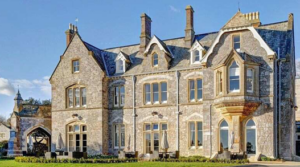
Lincombe Manor: The Palk/Haldon family finally left Torquay in 1914.
Power shifted further with the 1918 Representation of the People Act which extended the vote to the working-class and made Britain into a modern mass democracy. It quickly prompted politicians to seek new ways of ensuring the wellbeing of ordinary voting folk.
Perhaps the greatest transformation was in women’s lives. During the conflict many had acquired a wage, a degree of independence, and more personal freedom. We only need to contrast photographs of Torquay from before and after the war to see, for example, women with shorter hair and shorter dresses, smoking, drinking, and driving motorcars. The ‘flapper’ appears, perplexing a staid seaside society.
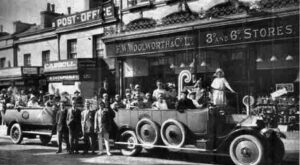
A town for leisure and pleasure. Charabancs in Union Street
All this was to a background of an explosion in popular culture, from the movies, social dancing, musical theatre, sport, or just home entertainment via the gramophone record and wireless. Offering a soundtrack for the era was Jazz which emerged as a distinctive musical genre. 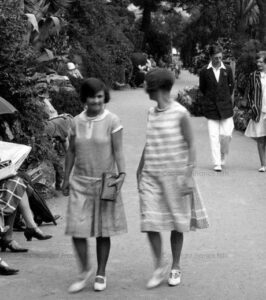
A transformation in women’s lives. Shorter hair, shorter dresses, pictured at Rock Walk
As the world moved on, opera, that great art form of the nineteenth century, became to be seen as something of an anachronism. And so, once one of the most ambitious examples in Britain of monumental theatre design, it became clear that the Scala would never fulfil its original purpose. Nevertheless, it still stands on Torwood Street, a metaphor for how much Torquay had changed in a few short years.
Much remodelled on the ground floor, but not above, over the years the building has been used as a car showroom, the ‘Victorian Arcade’, retail, fast food outlets, and nightclubs.
Even though now just a shell, a husk, the Scala’s survival and tenacity does prove that we don’t always need to demolish and rebuild. We can adopt and adapt, time and again, to cater for the latest forms of entertainment and leisure while retaining architectural jewels from Torquay’s past.
Torquay: A Social History by local author Kevin Dixon is available for £10 from Artizan Gallery, Fleet Street, Torquay, or:
https://www.art-hub.co.uk/product-page/torquay-a-social-history-by-kevin-dixon



